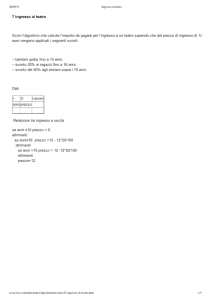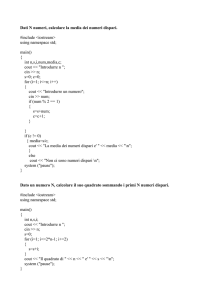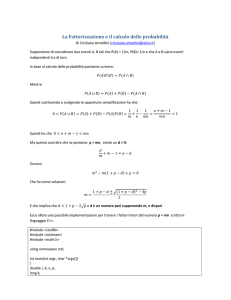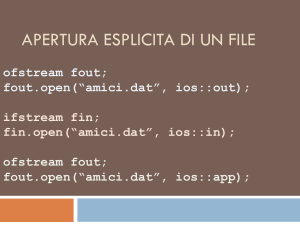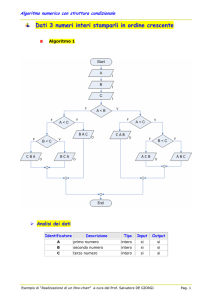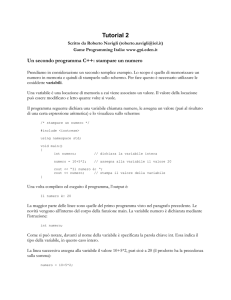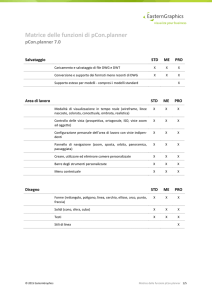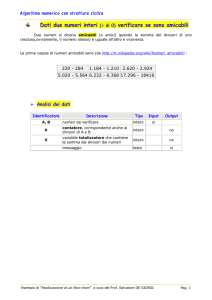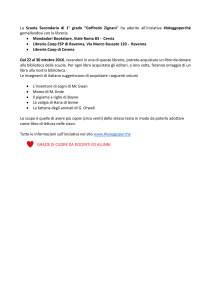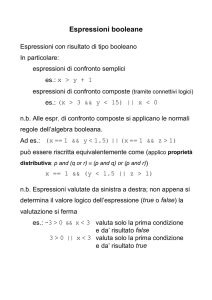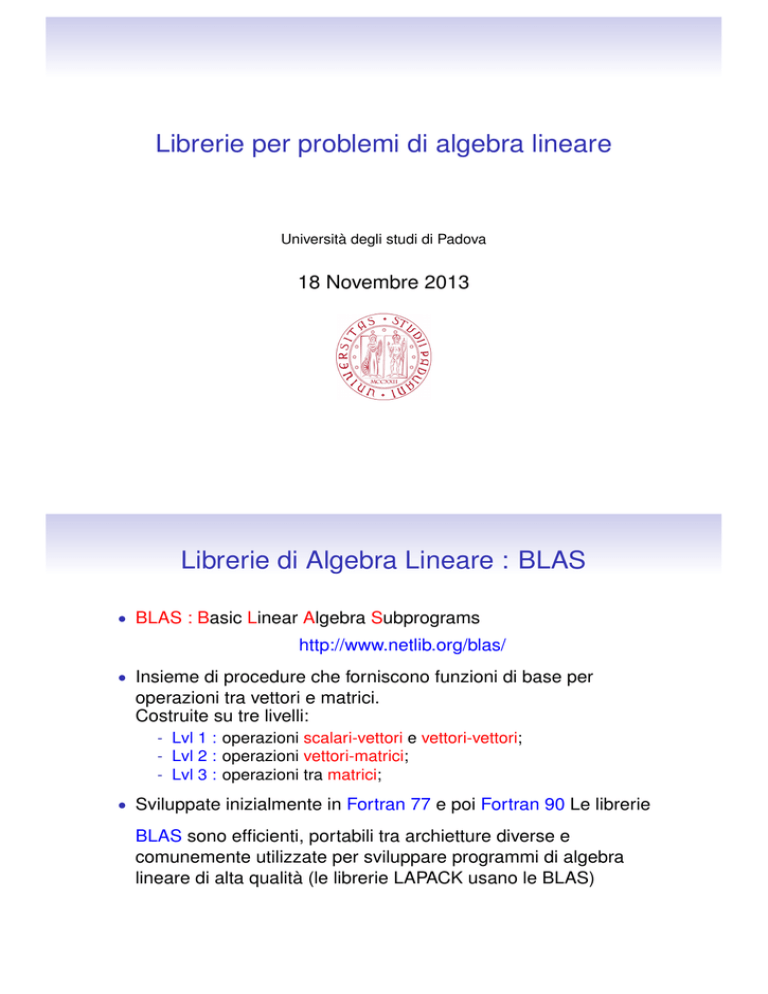
Librerie per problemi di algebra lineare
Università degli studi di Padova
18 Novembre 2013
Librerie di Algebra Lineare : BLAS
• BLAS : Basic Linear Algebra Subprograms
http://www.netlib.org/blas/
• Insieme di procedure che forniscono funzioni di base per
operazioni tra vettori e matrici.
Costruite su tre livelli:
- Lvl 1 : operazioni scalari-vettori e vettori-vettori;
- Lvl 2 : operazioni vettori-matrici;
- Lvl 3 : operazioni tra matrici;
• Sviluppate inizialmente in Fortran 77 e poi Fortran 90 Le librerie
BLAS sono efficienti, portabili tra archietture diverse e
comunemente utilizzate per sviluppare programmi di algebra
lineare di alta qualità (le librerie LAPACK usano le BLAS)
Librerie di Algebra Lineare : LAPACK
• LAPACK : Linear Algebra PACKage
http://www.netlib.org/lapack/
• routines scritte in Fortran 90 che permttono di risolvere sistemi di
equazioni lineari, calcolo di autovalori ed autovettori,
fattorizzazioni di matrici, etc. Le librerie trattano matrici dense e a
banda, ma non matrici sparse in generale. Le librerie sfruttano
pesantemente le BLAS delle quali espandono il Livello 3.
Esistono delle API in C che permettono di utilizzare le LAPACK,
sviluppate in collaborazione con INTEL
http://software.intel.com/en-us/articles/intel-math-kernel-library-documentation/
Librerie di Algebra Lineare : BOOST
• BOOST : Free Peer-reviewed portable C++ source libraries
http://www.boost.org
• insieme di librerie che integrano molto bene la Standard Library
del C++.
• recentemente dieci librerie sono state incluse nello standard del
linguaggio (C++ 11)
• sono divise in sotto librerie che coprono argomenti i più disparati
(algoritmi, array, operazioni atomiche, contenitori, date-time,
grafici, logging, lambda, network, funzioni matematiche, etc).
Librerie di Algebra Lineare : uBLAS
• uBLAS : una template class library che incorpora le funzionalità
BLAS per matrici dense, packed e sparse.
http://www.boost.org/doc/libs/1_54_0/libs/numeric/ublas/doc/index.htm
• it provides provides templated C++ classes for dense, unit and
sparse vectors, dense, identity, triangular, banded, symmetric,
hermitian and sparse matrices. Views into vectors and matrices
can be constructed via ranges, slices, adaptor classes and
indirect arrays. The library covers the usual basic linear algebra
operations on vectors and matrices: reductions like different
norms, addition and subtraction of vectors and matrices and
multiplication with a scalar, inner and outer products of vectors,
matrix vector and matrix matrix products and triangular solver.
The glue between containers, views and expression templated
operations is a mostly STL conforming iterator interface.
I Vettori in uBLAS
• L’utilizzo di vettori e matrici è intuitivo e semplice.
• Un vettore di double viene creato e inizializzato da
vector<double> v(unsigned int n, double x)
con n numero di elementi del vettore e x valori di default.
• si possono creare vettori speciali
unit_vector<double> v(unsigned int n)
zero_vector<double> v(unsigned int n)
• si possono eseguire operazioni tra vettori e tra vettori e scalari.
#include <boost/numeric/ublas/vector.hpp>
using namespace boost::numeric::ublas;
uBLAS: vector class
#include <boost/numeric/ublas/vector.hpp>
#include <boost/numeric/ublas/io.hpp>
using namespace boost::numeric::ublas;
[3](2,-5,2)
-1
9
5.74456
5
1
int main( )
{
vector <double> v(3, 2.0);
v[1] = -5.0
norm_1 =
P
i
|vi |
std::cout << v << std::endl;
std::cout
std::cout
std::cout
std::cout
std::cout
}
<<
<<
<<
<<
<<
sum(v) << std::endl;
norm_2 =
norm_1(v) << std::endl;
norm_2(v) << std::endl;
norm_inf(v) << std::endl;
index_norm_inf(v) << std::endl;
qP
i
vi2
norm_inf = MAX(|vi |)
uBLAS: vector operations
#include <boost/numeric/ublas/vector.hpp>
#include <boost/numeric/ublas/io.hpp>
using namespace boost::numeric::ublas;
int main( )
v1:
v1: [3](2,-2,2)
[3](2,-2,2) |
| v2:
v2: [3](1,-1.5,1)
[3](1,-1.5,1)
{
v1
+
v2
:
[3](3,-3.5,3)
|
v1:+ [3](2,-2,2)
v1
v2 : [3](3,-3.5,3)
| v2: [3](1,-1.5,1)
| v1
v1 - v2
v2 :
:
vector <double> v1(3, 2.0);
[3](1,-0.5,1)
v1:
| v2: [3](1,-1.5,1)
v1 + [3](2,-2,2)
[3](1,-0.5,1)
v2 : [3](3,-3.5,3)
| v1 - v2 :
inner_prod(v1,v2)
:
v1[1] = - v1[1];
v1
+ v2 : [3](3,-3.5,3)
inner_prod(v1,v2)
[3](1,-0.5,1)
: 7
7 | v1 - v2 :
outer_prod(v1,v2)
:
[3](1,-0.5,1)
outer_prod(v1,v2)
:
vector <double> v2(3, 1.0);
[3,3]((2,-3,2),(-2,3,-2),(2,-3,2))
inner_prod(v1,v2) : 7
[3,3]((2,-3,2),(-2,3,-2),(2,-3,2))
v2[1] = -1.5;
v1 * k : [3](4,-4,4) | v1 / k : [3](4,-4,4)
std::cout << "v1: " << v1;
<< "v2: " << v2 << std::endl;
std::cout << " v1 + v2 : " << v1 + v2 << " | ";
std::cout << " v1 - v2 : " << v1 - v2 << std::endl;
std::cout << inner_prod(v1,v2) << std::endl;
std::cout << outer_prod(v1,v2) << std::endl;
double k = 2.0;
std::cout << " v1 * k : " << v1 * k << " | ";
std::cout << " v1 / k : " << v1 * k << std::endl;
}
Le Matrici in uBLAS
• Un matrice è creata tramite
matrix<T> A(unsigned int righe, unsigned int col)
con T classe templata
• ci sono due funzioni che ritornano il numero di righe size1() e di
colonne size2() della matrice.
• È possibile creare matrici speciali, quella identità e la matrice nulla:
identity_matrix<T> I(unsigned int nrighe, unsigned
int ncol)
7
zero_matrix<T> O(unsigned int nrighe, unsigned int
ncol)
#include <boost/numeric/ublas/matrix.hpp>
using namespace boost::numeric::ublas;
Systems of Linear Equations
7
Systems of Linear Equations
A simple electrical network contains a number of resistances and a single
source of electromotive force (a battery) as shown in Figure 7.1. Using
Kirchhoff’s laws and Ohm’s law, we can write a system of linear equations
that govern this circuit. If x1 , x2 , x3 , and x4 are the loop currents as shown,
then
the equations
arenetwork contains a number of resistances and a single
A simple
electrical
source of electromotive
force (a battery) as shown in Figure 7.1. Using
15x
−
2x2 − 6x3
= 300
1
Kirchhoff’s laws
and Ohm’s law, we can write a system of linear equations
−2x + 12x − 4x3 − x4 = 0
x4 are the loop currents as shown,
that govern this circuit.1 If x1 , x22 , x3 , and
−6x − 4x2 + 19x3 − 9x4 = 0
then the equations
are1
− x2 − 9x3 + 21x4 = 0
15x1 − 2x2 − 6x3
= 300
Systems of equations
like this, even those that contain hundreds of un−2x1 + 12x2 − 4x3 − x4 = 0
knowns, can be solved
by using
the methods developed
0 in this chapter.
−6x
1 − 4x2 + 19x3 − 9x4 =
The solution to the preceding−system
x2 −is 9x3 + 21x4 = 0
Esempio: soluzione di un sistema lineare
26.5
xlike
9.35 evenx3those
= 13.3
x4 = 6.13
2 = this,
Systemsx1of=equations
that contain
hundreds of unknowns, can be solved by using the methods developed in this chapter.
!
The solution to the preceding7system
is
x1 = 26.5
300 volts
x2 = 9.35
7!
x1
x23!= 13.3
x2
4!
1!
x3
FIGURE 7.1
Electrical
network
2!
6!
300 volts
x1
x45 != 6.13
x4
9!
x2
5!
11 !
4!
1!
x3
x4
9!
#include <boost/numeric/ublas/matrix.hpp>
#include <boost/numeric/ublas/vector.hpp>
#include <boost/numeric/ublas/lu.hpp>
#include <boost/numeric/ublas/io.hpp>
using namespace boost::numeric::ublas;
x = [4](26.5492,9.3537,13.255,6.12613)
A * x = [4](300,1.42e-14,-1.42e-14,-2.84e-14)
int main()
b = [4](300,0,0,0)
{
matrix<double> A(4, 4, 0.0);
A(0,0) = 15; A(0,1) = -2; A(0,2) = -6; A(0,3) = 0;
A(1,0) = -2; A(1,1) = 12; A(1,2) = -4; A(1,3) = -1;
A(2,0) = -6; A(2,1) = -4; A(2,2) = 19; A(2,3) = -9;
A(3,0) = 0;
A(3,1) = -1; A(3,2) = -9; A(3,3) = 21;
matrix<double> Acopy(A);
permutation_matrix<double> P(4);
vector<double> b(4, 0.0);
b[0] = 300.0;
vector<double> x(4, 0);
lu_factorize(Acopy, P); // A e P contengono la fattorizzazione LU di A
x = b;
lu_substitute(Acopy, P, x);
std::cout << " x = " << x << std::endl;
std::cout << " A * x = " << prod(A, x) << std::endl;
std::cout << " b = " << b << std::endl;
return 0;
}

